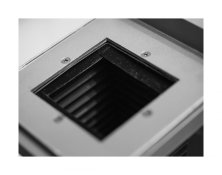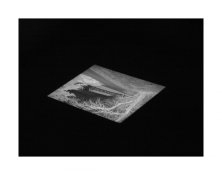This is a fascinating problem. I tried some experiments with my Omega B66XL dichroic enlarger to gain some insight. I chose this machine because it is of a similar size to the LPL/Saunders 6700 dichroic enlarger. Each test was done without any safelights on to maximize my ability to see any stray light.
First, I installed an empty 35mm negative carrier and a 50mm f/4 EL Nikkor and focused the image of the edge of the carrier onto the baseboard. I saw nothing but the image of the illuminated window of the carrier.
Next, I placed an empty 6 x 6cm carrier and an 80mm f/5.6 EL Nikkor in the enlarger and focused the image of the carrier opening as before. It took a second or two to realize that there was an extremely faint set of concentric squares, possibly 3 or 4, surrounding the main image. Clearly, I was seeing the image of light reflected by the inner folds of the topmost portion of the bellows. The 80mm lens throws a large enough circle towards the film to “see” the highlights reflected from the bellows.
I generally reserve this machine for 35mm enlarging, but I have used it occasionally for 6 x 6cm work. I hadn’t previously noticed the projection of the squares.
Next, I put an average-density 6 x 6cm negative into the carrier. With the aperture wide open on the 80mm lens at f/5.6 I didn’t initially see anything outside of the projected image. However, after 10 seconds or so my dark vision gained enough sensitivity to barely make out the brightest line nearest the front. I could no longer distinguish full squares. This was so dim as to be close to the limit of my ability to perceive it. Closing the aperture to f/8 made it much harder to find. At f/11 it was almost imperceptible. On my B66, the effect was only noticeable without a negative in the carrier. When I put the negative in, it was quite hard to locate the spurious light at the baseboard.
It’s obvious that on my B66 this is caused by the longer lens seeing the illuminated edges of the folds in the bellows due to the size of the pickup circle towards the negative. The 50mm lens can’t see the folds due to its smaller pickup circle (even though both lenses have similar angles of view).
The only way to totally eliminate this is to choose an enlarger with bellows sufficiently large enough that the lens can’t see the bellows or the edges of the opening in the negative stage. For example, an 80mm lens is unlikely to see the reflections of the bellows or negative stage of a 4” x 5” or bigger enlarger.
This is likely inescapable for enlargers with bellows just big enough for the largest format for which they were designed when using the longest lenses for that format. The upper parts of the bellows and, in some cases, the negative stage opening are visible to the lens. Bright reflections are necessarily projected to the baseboard, even if only dimly.
Regarding Post #26, I agree that replacing the temporary black paper mask with one made of the most light-absorbing black cloth, such as felt, velvet, or whatever you can find will reduce the effect as much as possible.
Ultimately, it doesn’t matter. The miniscule amount of light in the projection of the bellows folds or of the edges of the opening in the negative stage falls well outside of the enlarging paper and is, therefore, irrelevant.














